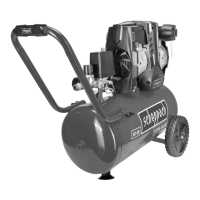11
10. Cleaning, maintenance and storage
m Attention!
Pull out the mains plug before carrying out any clean-
ing and maintenance work! Risk of injury from electric
shock!
m Attention!
Wait until the equipment has cooled down complete-
ly! Danger of burning!
m Attention!
Always depressurise the equipment before carrying
out any cleaning and maintenance work! Danger of
injury!
10.1 Cleaning
• Keep the device as free of dust and dirt as possible.
Rub the device clean with a clean cloth or blow it o
with compressed air at low pressure.
• We recommend that you clean the device directly
after every use.
• Clean the device at regular intervals using a damp
cloth and a little soft soap. Do not use aggressive
cleaning agents or solvents; they could attack the
plastic parts of the device. Make sure that no water
can penetrate the device interior.
• The hose and injection tools must be disconnected
from the compressor before cleaning. The com-
pressor must not be cleaned with water, solvents
or similar.
10.2 Maintaining the pressure vessel (g. 1)
Attention!
To ensure a long service life for the pressure vessel
(8), drain o the condensate after each use by open-
ing the drain screw (6).
Release the vessel pressure rst (see 10.6.1). Open
the drain screw (6) by turning counter-clockwise
(when looking at the screw from the bottom of the
compressor) so that the condensate can be com-
pletely drained out of the pressure vessel (8).
Then close the drain screw (6) again (turn it clock-
wise). Check the pressure vessel (8) for rust and
damage each time before use.
Do not use the compressor with a damaged or rusty
pressure vessel (8). If you discover damage, please
contact the customer service workshop.
10.3 Safety valve (g. 7)
The safety valve (9) has been set for the highest per-
mitted pressure of the pressure vessel (8). It is not
permitted to adjust the safety valve (9) or remove the
connection lock (9b) between the exhaust nut (9a)
and its cap (9c). Actuate the safety valve (9) every
30 operating hours but at least 3 times a year to en-
sure that it works when required. Turn the perforated
exhaust nut (9a) counterclockwise to open it and use
your hands to pull the valve rod outwards over the
perforated exhaust nut (9a) to open the outlet of the
safety valve (9). Now, the valve audibly releases air.
Then, tighten the exhaust nut (9a) clockwise again.
10.4 Cleaning the air lter (g. 8, 9)
The air lter (4) prevents dust and dirt being sucked
in. It is essential to clean this air lter (4) after at least
every 300 hours in service. A blocked air lter (4) sig-
nicantly reduces the compressor power.
Turn the air lter (4) counterclockwise to remove it.
Open the lter cover (4c) and remove it. You can now
take out the lter element (4b). Carefully tap out the
lter element (4b), the lter cover (4c) and the lter
housing (4a). These components must then be blown
out with compressed air (approx. 3 bar) and reassem-
bled in reverse order.
10.5 Service information
With this product, it is necessary to note that the fol-
lowing parts are subject to natural or usage-related
wear, or that the following parts are required as con-
sumables.
Wearing parts*:air lter
* may not be included in the scope of supply!
10.6 Storage
m Attention!
Pull out the mains plug and ventilate the equip-
ment and all connected pneumatic tools. Store
the compressor in such a way that it cannot be
used by unauthorised persons.
m Attention!
Store the compressor only in a dry location
which is not accessible to unauthorised persons.
Always store upright, never tilted!
10.6.1 Releasing excess pressure
Release the excess pressure by switching o the
compressor and using the compressed air which is
still left in the pressure vessel (8), e. g. with a com-
pressed air tool running in idle mode or with a blow-
out pistol.
11. Transport
Use the transport handle (1) to transport the device,
and drive the compressor with it.
When lifting the compressor, note its weight (see
Technical data).
Ensure that the load is well secured when transport-
ing the compressor in a motor vehicle.

